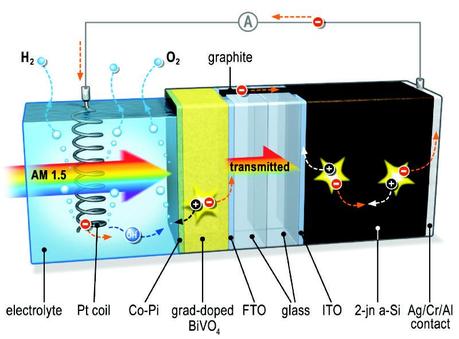 Research Headline:
Research Headline:Helmholtz-Zentrum Berlin (HZB) and TU Delft scientists have successfully stored nearly five percent of solar energy chemically in the form of hydrogen using a simple solar cell and a photo anode made of a metal oxide.
"Basically, we combined the best of both worlds...We start with a chemically stable, low cost metal oxide, add a really good but simple silicon-based thin film solar cell, and -- voilà -- we've just created a cost-effective, highly stable, and highly efficient solar fuel device." Explained Prof. Dr. Roel van de Krol, head of the HZB Institute for Solar Fuels.(reference)
This is a major feat as the design of the solar cell is much simpler than that of the high-efficiency triple-junction cells based on amorphous silicon or expensive III-V semiconductors that are traditionally used for this purpose. The photo anode, which is made from the metal oxide bismuth vanadate (BiVO4) to which a small amount of tungsten atoms was added, was sprayed onto a piece of conducting glass and coated with an inexpensive cobalt phosphate catalyst.
When light hits the system, an electrical potential builds up. The metal oxide layer acts as a photo anode and is the site of oxygen formation. It is connected to the solar cell by way of a conducting bridge made of graphite (black). Since only the metal oxide layer is in contact with the electrolyte, the silicon solar cell remains safe from corrosion. A platinum spiral serves as the cathode where hydrogen is formed.
Find Full article: Nature
ENJOYED THIS POST? Subscribe and Like Us on Facebook or Google Plus! No Spam!
